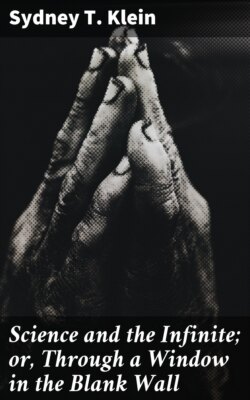Science and the Infinite; or, Through a Window in the Blank Wall

Реклама. ООО «ЛитРес», ИНН: 7719571260.
Оглавление
Sydney T. Klein. Science and the Infinite; or, Through a Window in the Blank Wall
Science and the Infinite; or, Through a Window in the Blank Wall
Table of Contents
SCIENCE AND THE INFINITE
VIEW ONE
CLEARING THE APPROACH
VIEW TWO
THE VISION
VIEW THREE
MYSTICISM AND SYMBOLISM
VIEW FOUR
LOVE IN ACTION
VIEW FIVE
THE PHYSICAL FILM
VIEW SIX
SPACE
VIEW SEVEN
TIME
VIEW EIGHT
CREATION
Отрывок из книги
Sydney T. Klein
Published by Good Press, 2019
.....
Even apart from our senses we find Motion giving the characteristics of solidity: a wheel with only a few spokes, if rotated quickly enough, becomes quite impermeable to any substance, however small, thrown at it; a thin jet of water only half an inch in diameter, if discharged at great pressure equivalent to a column of water of 500 metres, cannot be cut even with an axe, it resists as though it were made of the hardest steel; a thin cord, hanging from a vertical axis, and being revolved very quickly, becomes rigid, and if struck with a hammer it resists and resounds like a rod of wood; a thin chain and even a loop of string, if revolved at great speed over a vertical pulley, becomes rigid and, if allowed to escape from the pulley, will run along the ground as a hoop.
Now with regard to this limit of time perception, which gives us the phenomenon of Solidity, I have lately been able to devise an arrangement which, acting as a microscope for Time, gives the sensation of an increase in sight perception up to several thousand units per second; it is based on the fact that though the eye can only see six times per second it can see for the one-millionth part of a second. An example of this is the well-known experiment of seeing a bullet in its flight; the bullet makes electrical connection resulting in a spark which illuminates the bullet when opposite the eye. The electrical spark exists only for the millionth of a second, and as the bullet in that time has no perceptible movement it is seen standing absolutely still with all marks upon it quite visible to the eye. When Sight perception is increased up to the rate at which time may be said to flow for any particular object we apparently get into the reality, the permanent now where motion ceases to exist as a sensation. A tuning-fork, kept vibrating, by means of an electro-magnet, at 2000 times per second, may to our sense of sight be gradually slowed down and, optically, brought absolutely to a standstill, for as long as desired, and the smallest irregularity of its surface may be minutely examined, though it continues to be heard and felt vibrating at that enormous rate. I have made several experiments in this direction, and some very curious facts connected with the sensation of Motion are brought to light by means of this increase in perceptive power. If the sense of sight is increased to 125 units per second, motion at the rate of one inch per second is barely visible; taking the common house-fly, whose wings vibrate about 400 times per second, its units of perception would appear to be about two-thirds of those beats, as I found it had no cognisance of Motion below two inches per second; you can put your finger on any fly provided you do not approach it faster than the above rate, it turns its head up to look at your finger but can see no motion in it; if you approach at over three inches per second it will always fly away before you are within a foot. I found that a dragon-fly, whose wings vibrate about 200 times per second, had only half the number of unit perceptions of the fly and could apparently see motion at about one inch per second but not under. In the converse of the above we have then the principle of a Microscope for Time, somewhat similar to the Microscope for Space of our laboratories. If our perception were increased sufficiently we could slow down any motion for examination, however rapid; there would be no difficulty in following a lightning flash or even arresting its visible motion for purposes of investigation without interfering with the natural sequence of cause and effect.
.....